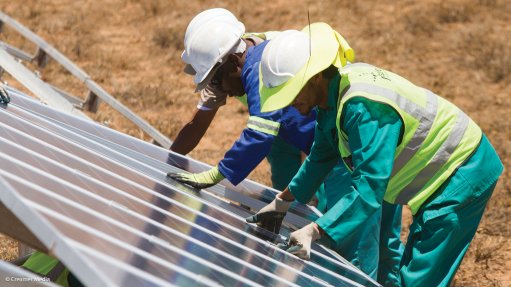Cranes For Tankhouses
This article has been supplied as a media statement and is not written by Creamer Media. It may be available only for a limited time on this website.
The African market for tankhouse cranes is flourishing, with strong demand in a geographical band stretching from the Equator to the Tropic of Capricorn. For end users of this type of crane, the main concern remains the same – prompt and effective after sales service.
Tankhouse cranes are double-girder electric travelling overhead machines that lift and position copper plates and slabs during electrolysis, the fourth and final step of the pyrometallurgical refining process used with certain types of copper ore.
In this fourth step, anodic copper slabs which have already attained 99 percent purity during three prior processes are hung in large tanks filled with an electrolyte solution of copper sulphate and sulphuric acid. Small, thin sheets of pure copper are then suspended between these anodes and an electric current is applied. Positively charged copper ions leave the anodic slabs and move in solution through the electrolyte to place themselves on the cathodic sheets.
After some weeks, the slabs have disappeared and the sheets have grown to become thick copper plates of 99,99 percent purity, ready for removal by the tankhouse cranes for rinsing and despatch to factories that produce copper wire, tubing and other products.
One leading crane manufacturer, Condra, reports that tenders for as many as 30 tankhouse cranes are currently under evaluation. Eight are for mines in the Phalaborwa and Rustenburg areas of South Africa, and 22 are for the Central African Copperbelt – ten for mines in Zambia and twelve for the southern Democratic Republic of the Congo.
Crane capacities are all around 5 tons, with a dual bottom-block system on each one to keep the sheets level while they are moved.
The total value of all these tenders is some R120-million, tankhouse cranes being technically advanced machines priced at about R2,5-million each excluding cabins, air conditioning and the special ergonomics usually ordered as extras to cater for the very high crane speeds – about twice as fast as the average man can run.
Previously, Condra has manufactured tankhouse cranes that include three double-girder overhead machines for the copper and cobalt leaching plants at the Ruashi Mine near Lubumbashi in the southern DRC, and an undisclosed number of machines for similar plants at a copper mine in Zambia.
To achieve effective levels of production during electrolysis, Condra designs these cranes to achieve high long-travel speeds of between 100 and 140 metres per minute (the standard speed for overhead crane long-travel is around 30 metres per minute).
The company also keeps an eye on the corrosive nature of the tankhouse environment, offering a pressure test on crane girders in addition to the special paint specifications usually requested by the end user. Pressure applied internally to the girders allows weld seams to be checked for pinhole leaks, with a temporary application of liquid soap showing bubbling if seam integrity has been compromised.
The test ensures protection against internal corrosion caused by corrosive fumes being sucked into the girder as it expands during the heat of the day.
There must also be effective crane service and maintenance which, according to Condra, is lacking among European competitors because of the absence of local agents with spare parts holdings and a qualified service ability. Spare parts ordered from Europe can take up to two months to arrive.
By contrast, Condra’s agent for the Copperbelt, Kitwe-based EC Mining, holds readily available stocks of spare parts and carries out machine maintenance at all installation sites.
As an example of the problems that poor after sales service can cause, Condra points to a Copperbelt mine where spares and maintenance is no longer available for two cranes supplied by a northern hemisphere competitor.
Condra is in talks with the management at this mine about converting the installed cranes to Condra standard so that they can be properly maintained.
A similar situation at a Cape Town zinc plant recently resulted in three overhead cranes undergoing this type of conversion at Condra’s Germiston works, outside Johannesburg, to facilitate effective maintenance into the future.
Comments
Press Office
Announcements
What's On
Subscribe to improve your user experience...
Option 1 (equivalent of R125 a month):
Receive a weekly copy of Creamer Media's Engineering News & Mining Weekly magazine
(print copy for those in South Africa and e-magazine for those outside of South Africa)
Receive daily email newsletters
Access to full search results
Access archive of magazine back copies
Access to Projects in Progress
Access to ONE Research Report of your choice in PDF format
Option 2 (equivalent of R375 a month):
All benefits from Option 1
PLUS
Access to Creamer Media's Research Channel Africa for ALL Research Reports, in PDF format, on various industrial and mining sectors
including Electricity; Water; Energy Transition; Hydrogen; Roads, Rail and Ports; Coal; Gold; Platinum; Battery Metals; etc.
Already a subscriber?
Forgotten your password?
Receive weekly copy of Creamer Media's Engineering News & Mining Weekly magazine (print copy for those in South Africa and e-magazine for those outside of South Africa)
➕
Recieve daily email newsletters
➕
Access to full search results
➕
Access archive of magazine back copies
➕
Access to Projects in Progress
➕
Access to ONE Research Report of your choice in PDF format
RESEARCH CHANNEL AFRICA
R4500 (equivalent of R375 a month)
SUBSCRIBEAll benefits from Option 1
➕
Access to Creamer Media's Research Channel Africa for ALL Research Reports on various industrial and mining sectors, in PDF format, including on:
Electricity
➕
Water
➕
Energy Transition
➕
Hydrogen
➕
Roads, Rail and Ports
➕
Coal
➕
Gold
➕
Platinum
➕
Battery Metals
➕
etc.
Receive all benefits from Option 1 or Option 2 delivered to numerous people at your company
➕
Multiple User names and Passwords for simultaneous log-ins
➕
Intranet integration access to all in your organisation





















